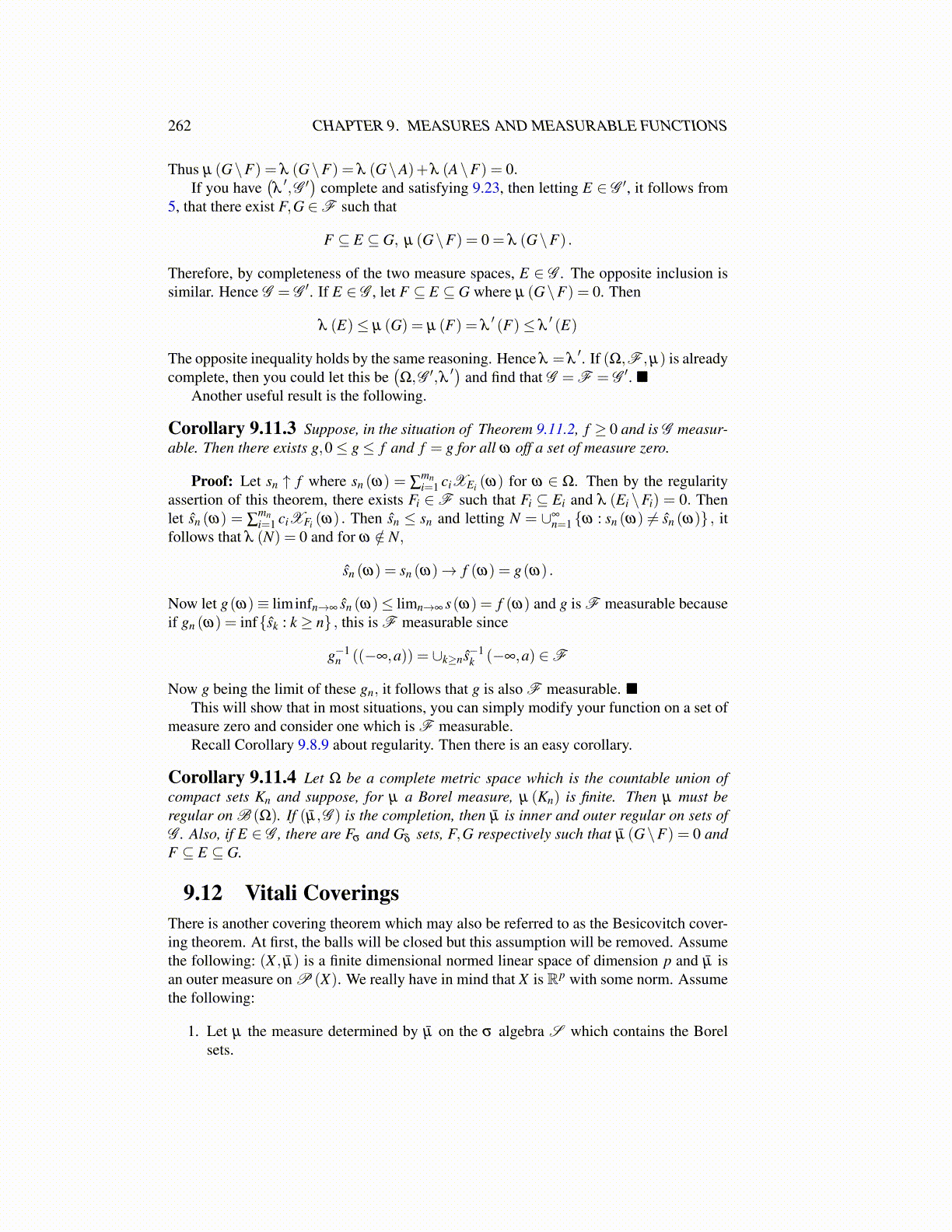
262 CHAPTER 9. MEASURES AND MEASURABLE FUNCTIONS
Thus µ (G\F) = λ (G\F) = λ (G\A)+λ (A\F) = 0.If you have
(λ′,G ′
)complete and satisfying 9.23, then letting E ∈ G ′, it follows from
5, that there exist F,G ∈F such that
F ⊆ E ⊆ G, µ (G\F) = 0 = λ (G\F) .
Therefore, by completeness of the two measure spaces, E ∈ G . The opposite inclusion issimilar. Hence G = G ′. If E ∈ G , let F ⊆ E ⊆ G where µ (G\F) = 0. Then
λ (E)≤ µ (G) = µ (F) = λ′ (F)≤ λ
′ (E)
The opposite inequality holds by the same reasoning. Hence λ = λ′. If (Ω,F ,µ) is already
complete, then you could let this be(Ω,G ′,λ ′
)and find that G = F = G ′. ■
Another useful result is the following.
Corollary 9.11.3 Suppose, in the situation of Theorem 9.11.2, f ≥ 0 and is G measur-able. Then there exists g,0≤ g≤ f and f = g for all ω off a set of measure zero.
Proof: Let sn ↑ f where sn (ω) = ∑mni=1 ciXEi (ω) for ω ∈ Ω. Then by the regularity
assertion of this theorem, there exists Fi ∈F such that Fi ⊆ Ei and λ (Ei \Fi) = 0. Thenlet ŝn (ω) = ∑
mni=1 ciXFi (ω) . Then ŝn ≤ sn and letting N = ∪∞
n=1 {ω : sn (ω) ̸= ŝn (ω)} , itfollows that λ (N) = 0 and for ω /∈ N,
ŝn (ω) = sn (ω)→ f (ω) = g(ω) .
Now let g(ω)≡ liminfn→∞ ŝn (ω)≤ limn→∞ s(ω) = f (ω) and g is F measurable becauseif gn (ω) = inf{ŝk : k ≥ n} , this is F measurable since
g−1n ((−∞,a)) = ∪k≥nŝ−1
k (−∞,a) ∈F
Now g being the limit of these gn, it follows that g is also F measurable. ■This will show that in most situations, you can simply modify your function on a set of
measure zero and consider one which is F measurable.Recall Corollary 9.8.9 about regularity. Then there is an easy corollary.
Corollary 9.11.4 Let Ω be a complete metric space which is the countable union ofcompact sets Kn and suppose, for µ a Borel measure, µ (Kn) is finite. Then µ must beregular on B (Ω). If (µ̄,G ) is the completion, then µ̄ is inner and outer regular on sets ofG . Also, if E ∈ G , there are Fσ and Gδ sets, F,G respectively such that µ̄ (G\F) = 0 andF ⊆ E ⊆ G.
9.12 Vitali CoveringsThere is another covering theorem which may also be referred to as the Besicovitch cover-ing theorem. At first, the balls will be closed but this assumption will be removed. Assumethe following: (X , µ̄) is a finite dimensional normed linear space of dimension p and µ̄ isan outer measure on P (X). We really have in mind that X is Rp with some norm. Assumethe following:
1. Let µ the measure determined by µ̄ on the σ algebra S which contains the Borelsets.